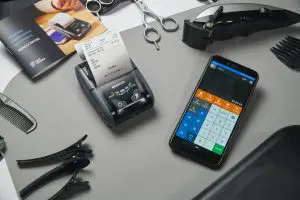The modern world is all about convenience.
We want things to be as easy and accessible as possible, which makes it understandable why so many people are exploring the opportunity of becoming a transcriptionist.
Gone are the days when this was an activity that only took place in offices, now anyone can work from home and do transcription – not just those with specialist training.
How does someone go about making this dream come true? How do you become a transcriber?
This article will explore these questions and more, providing practical advice on how to start your transcription career today!
But first, let’s understand a few terms.
What is Transcription and Who is a Transcriptionist?
Transcription is the process of converting audio or video recordings, such as MP3 files, into text format.
A transcriptionist (or transcriber) is a person who listens to recorded speech and types it into documents that are commonly called transcripts.
These transcripts can be used for many purposes, including creating subtitles in language translation software.
What is general transcription?
General transcriptionists focus on all types of transcription except medical transcription.
In this field, you may take dictation or transcribe conference calls, workshops, speeches, videos lectures phone messages interviews video similar audio or material to transform them into a typed format.
Who is cut out for general transcription?
You should be a decent typist with good hearing or listening skills.
Additionally, it helps to have lasting patience! Sometimes there are audio files out there where the sound quality isn’t high enough and can take forever to go through those difficult parts successfully.
Is it hard to be a transcriptionist?
Transcription work isn’t easy, but it’s a great way to train at home and earn money while working from anywhere you have access to the internet.
However, this is not an overnight income opportunity – most people take months before they can make more than minimum wage transcribing online.
Why is general transcription a highly recommended work-from-home option?
There are many companies that allow you to work from home, and transcription is often non-phone work.
It’s also flexible and a great option for beginners who want jobs without having passed the preliminary tests of other positions in their field.
Vital equipment needed for general transcription
First off, a computer is essential for this job.
Then there’s internet access with which you can find work via your home or anywhere else that has an Internet connection (although it will be best if working from home).
You should also have some specific software and foot pedal – both optional but recommended! If so desired, having a headset instead of just using headphones/earphones would make life easier while transcribing audio clips too as they’re more comfortable than ear buds etc..
It doesn’t end here though; in order to become successful at general business medical or legal transcriptionist jobs , one must first learn how their tools function well enough before jumping right into any task assigned.
How much does a typical transcriptionist get paid?
Typical transcriptionists are paid anywhere from $20 to $50 per audio hour, depending on how fast they type and the quality of their work.
As a beginner, you may not be able to make as much money – but once you’ve gained some experience, try applying for higher-paying jobs or branching out into other types of transcription.
The easiest way to get started as a transcriptionist
The easiest way to get started as a transcriptionist is to apply for work from home jobs and become successful at them – then use the money you earn to build your skills and make more money later.
You can find work-from-home transcription jobs by looking on websites such as Indeed, Glassdoor, or simply doing an online search.
A quick Google search will usually yield a lot of results that offer transcription positions.
However, here are a few steps to get started.
Take a transcription training course.
This will help you learn what to expect from the job and how to do it properly. It can be done online or at a local school if there is one in your area that offers this specific type of training – otherwise, you’ll need either an internet connection or access to an actual classroom.
Set up your home office.
You won’t get paid without a quiet place to work, so make sure you have the space set up with all of the equipment and software that you need before starting any transcription jobs online .
Take notes while learning from your training course as well – this will help if it’s difficult for you to memorize certain parts of the profession.
Experience -Where can you get practice work?
Do all transcription companies require previous transcription experience?
It used to be that companies would only hire experienced transcriptionists, but now most are accepting beginners as well.
However, it’s still a good idea to take courses or even practice your own work on the side by working for yourself before applying to any company.
You can also find free sample audio clips online and use them for practice.
What is the best way to learn transcription?
The best way to start learning how to transcribe is by doing it.
But first, you’ll need access to audio clips that will teach you step-by-step what kind of equipment and software is needed as well as proper formatting techniques (since most companies require a specific format for their work).
There are a number of websites that offer free training as well, or you can find paid courses if your local college offers transcription classes.
You’ll also need to be able to type quickly in order to meet deadlines and get the best pay – so practice typing skills on any kind of regular basis at least once a day, if not more.
Check out a few transcription job listings on different websites.
If there’s anything you don’t understand in your training course, try looking for answers online as well – this is where most information can be found! It will also help to read through reviews and comments about companies offering transcription positions so that you know where to look before applying.
Start making money by transcribing audio files!
Once you’ve acquired all of the tools and skills necessary, it’s time to get started with your transcription job from home . Grab a cup of coffee or tea and start typing away – just make sure there aren’t any distractions while working so that you can get the most done in as little time as possible!
Transcription Salary- How much can you make as a transcriptionist?
Transcription is a very rewarding and important career, but it can be difficult to find work without previous experience. The best way for someone who is just starting out to get experience is by transcribing audio files on the job that they are paid for.
It is important to remember that each company has specific requirements, so it would be a good idea for someone planning on going into transcription as their career to research different companies before applying.
The average entry-level transcriptionist can expect to earn around $3.00 up to $11.00 an hour, depending on the company and their experience level.
This is due to the fact that it takes longer for beginners compared with those who have more experience as well as companies hiring beginners tend pay low rates in general since they are newbies at this job field.
Get transcription jobs – Who hires for work from home transcription?
There are plenty of transcription jobs to be found online, all you have to do is fill out an application before applying.
The company may ask for a resume and cover letter as well, but some will just require you to fill in a form with your skills and experience. It’s also likely that you’ll need to answer a few questions about your typing speed as well.
As long as you meet the company’s requirements, there is a good chance that they will hire you!
Some sites don’t even require previous transcription experience – so if you’re new to this field, it’s a good idea to start practicing transcribing audio clips on the side. If not for yourself, for whoever pays!
Getting your first transcription job
As with any job, it’s important to have something to show when you’re applying for a transcription position. Even if you don’t have any previous experience, you can start practicing by transcribing audio clips that are publicly available.
You may also want to include your resumé and cover letter – either online or in the email that you send.
Ask these questions when filling out an application: “Do I meet all requirements?” “Do they require me to provide transcripts of my past experience?”
If you get an offer, go ahead and do a trial run before accepting. This is a good way of figuring out what company is best for you.
Benefits of Becoming a Transcriptionist
Freelance transcription benefits include being able to set your own hours, control your earnings, and have a flexible schedule.
Other perks of working from home are that you don’t need any special equipment or investment in order to work on the job either if this is something you want out of life!
Freelancers can enjoy great health and safety protocols as well since they’re at their most vulnerable when transcribing for clients so it’s important not only to choose reliable sources but also to stay safe while doing what one loves best-working.
How to become a certified transcriptionist
Transcription work is not for the faint of heart. To be a good fit for the position and to work on requests as smoothly as possible, one must have certain abilities.
Furthermore, it is critical to be able to transcribe accurately. Those who are interested in the job must:
- Have the ability to listen well. There is no standard method for recording audio. They may vary in length, quality, and type. A competent transcriber should be able to translate a recording into its text form as accurately as possible, whether it’s a crystal clear in-depth interview of only five minutes or a very muffled focus group discussion that
- Good research abilities are required. A transcriptionist may work on files ranging from medical, entertainment, and marketing topics, to name a few. In order to recognize hefty terminologies and proper names mentioned in the recording, research is critical. After all, if you can only type out each conversation accurately if the transcription is accurate.
- Good listening skills. Clients may want for word-for-word transcripts. Every single utterance should be recorded in this type, including the uhms and ahs, as well as the frequent types like ofs and sort ofs. An outstanding transcriber should be able to identify what is being said in the audio or video file – nothing more, nothing less.
- Reviewing transcripts for accuracy is an easy process. Grammar, capitalization, punctuation, and spelling should all be correct. It’s understandable to follow good grammatical techniques when working with written material.
- Be diligent and patient. As previously said, turning audio recordings into written reports is not simple. It might be annoying to repeat the audio over and over in order to catch that one phrase spoken by the speaker. Overwhelmingly attending a three-hour-long meeting with multiple crosstalks among its participants can be tiring as well.
- Be able to beat the deadline. Transcriptions, like any other report or project, are due on a specified date. Transcribers that are efficient making it a point to work on their files in order to be able to submit them promptly and without sacrificing the transcript’s quality, even if they come across problems.
- Be able to type fast and accurately. Speed is everything in this field, which means that typing as quickly and clearly as possible is critical for transcriptionists. If you’re not experienced at typing or have poor hand-eye coordination, transcribing maybe isn’t the best choice of profession for you.
Aside from special talents, transcribing requires a number of equipment and tools to complete. Here are the following must-have items for starting a transcription career:
- Good pair of earphones. It’s only natural to spend a little extra on headphones that will help you get the most out of your work. When it comes to listening, this is an area where you’ll find yourself putting in more time than any other industry. When working with challenging recordings, trust that an excellent set of earphones can provide you with an extra boost.
- Transcription software. Instead of manually playing or pausing the recording on your computer’s default audio or video player, consider using a transcription program to make transcribing much simpler. Express Scribe is an excellent choice since it includes hot keys and a foot pedal for easier control — simply tapping the buttons plays, pauses, rewinds, or fast forwards the material.
- Reliable internet connection. More than ever, the internet is now a must-have when conducting business. After recording the speech for transcription and then delivering the completed document to the customer, you may do it all over the web. Google has made fact-checking a snap. Having a current stable connection becomes more essential than simply having one; especially if you’re transcribing at home in between tasks during a day.
Although there are no set requirements for becoming a professional transcriptionist, certain organizations grant transcriptionist certifications to individuals who wish to learn more about the subject.
The National Court Reporter’s Association (NCRA) offers Registered Professional Reporters (RPR) as a certification. RPRs are assigned to handle court reports only and do not work on other types of legal documents. Some jurisdictions feel that additional licensing and training are required for individuals working on court transcripts because many legal matters are sensitive and confidential.
Meanwhile, for the medical sector, the Association for Healthcare Documentation Integrity (AHDI) is a group that provides educational seminars to encourage those who wish to become health transcriptionists.
AHDI also offers Registered Healthcare Documentation Specialist (RHDS) and Certified Healthcare Documentation Specialist (CHDS) certifications, which can be valuable add-ons to a veteran’s or a novice’s transcriptionist certification.
How to become a freelance transcriptionist
Freelance transcription jobs are widely available.
The first step is deciding what type of freelance transcription you would like to specialize in. This can be audio, video, or general transcription.
Your next step is to research the company you’re interested in working for. Look at their website and social media pages to make sure it’s a company that suits your needs and interests.
Once you’ve found a suitable company, email them with your portfolio attached. If you don’t have any portfolio items yet, you can ask for an opportunity to audition with some basic exercises they provide.
Once you get accepted, there are many benefits to freelancing as a transcriptionist: Setting your own hours and earning potential while being your own boss are just a few of the perks.
How to become a transcriptionist for Netflix
Netflix does not employ people directly. They engage hiring agents or non-employee captioning websites to find talent.
As a result, you must become a member of a freelance captioning site in order for Netflix to consider you. The website may be dedicated to (or simply for) captioning.
Final thoughts
If you are looking for a way to make extra money from home, general transcription may be the perfect career choice.
Unlike other work-from-home jobs that require skills in specific fields like coding or graphic design, anyone with a good grasp of the English language can become a successful transcriptionist!
Plus, there is no shortage of online companies and clients who need this service. So if you’re interested but don’t know where to start, we’ll walk you through it step by step.
Start your search now on online transcription jobs for beginners and find great opportunities available near you today!




